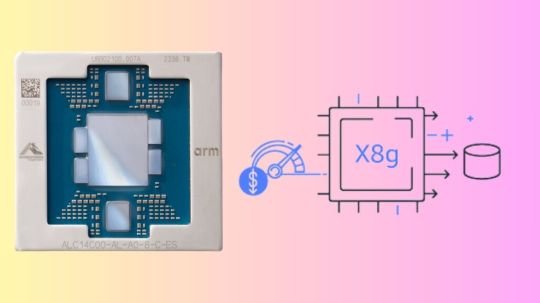#AmazonEC2X8g
Explore tagged Tumblr posts
Text
Amazon EC2 X8g: Graviton-4 Memory-Optimized AWS Instances

The most affordable price per gigabyte of memory among Graviton4-based EC2 instances is offered by Amazon Elastic Compute Cloud (Amazon EC2) X8g instances, which are driven by the most recent AWS Graviton4 processors. In addition, X8g instances provide up to 60% faster performance than X2gd instances and up to 3TiB of memory. They also offer larger instance sizes with up to three times more memory and vCPUs.
Customers can run memory-intensive workloads like in-memory databases (Redis, Memcached), relational databases (MySQL, PostgreSQL), electronic design automation (EDA) workloads, real-time big data analytics, and real-time caching servers with X8g instances’ increased performance and extra memory. To further optimize their computational infrastructure, X8g instances allow several memory-intensive containerized apps to run on a single instance. With up to 3 TiB of DDR5 memory and up to 192 vCPUs, Graviton-4-powered, memory-optimized X8g instances are now offered in 10 virtual sizes and two bare metal sizes.
With the finest price-performance and scale-up capability of any comparable EC2 Graviton instance to date, this instance is its most energy-efficient to date. These instances are optimized for Electronic Design Automation, in-memory databases & caches, relational databases, real-time analytics, and memory-constrained microservices, and have a memory to virtual CPU ratio of 16 to 1. The instances include with extra AWS Nitro System and Graviton4 security capabilities, and they completely encrypt all high-speed physical hardware interfaces.
This new instances are an even better host for these applications because they come in twelve sizes, giving you the option to scale up (using a larger instance) or scale out (using multiple instances). They also give you more flexibility for memory-bound workloads that are currently running on different instances.
The X8g instances vs X2gd instances
It offer three times as much memory, three times as many virtual CPUs, more than twice as much EBS capacity (40 Gbps vs. 19 Gbps), and twice as much network bandwidth (50 Gbps vs. 25 Gbps) as the previous generation (X2gd) instances.
With 160% more memory bandwidth and twice as much L2 cache per core as the Graviton2 processors in the X2gd instances (2 MiB vs. 1 MiB), the Graviton4 processors within the X8g instances can achieve up to 60% better compute performance.
The 5th generation of AWS Nitro System and Graviton4 processors, which include additional security features like Branch Target Identification (BTI) to protect against low-level attacks that try to disrupt control flow at the instruction level, are used in the construction of the X8g
ENA, ENA Express, and EFA Enhanced Networking are supported by the instances. The following table shows that they support all EBS volume types, including io2 Block Express, EBS General Purpose SSD, and EBS Provisioned IOPS SSD, and that they offer a sizable amount of EBS bandwidth.
Now let’s examine a few use cases and apps that can utilize up to 3 TiB per instance and 16 GiB of RAM per vCPU:
Databases: SAP HANA and SAP Data Analytics Cloud can now manage heavier and more ambitious workloads thanks to X8g instances. When compared to the same workloads operating on Graviton3 instances, SAP has measured up to 25% greater performance for analytical workloads and up to 40% better performance for transactional workloads when running on Graviton4 powered instances. SAP may now use Graviton-based utilization to even larger memory-bound solutions.
Workloads related to Electronic Design Automation (EDA) are essential to the process of developing, testing, confirming, and implementing new chip generations, such as Inferentia, Trainium, Graviton, and those that serve as the foundation for the Nitro System.
In order to take advantage of scalability and elasticity and provide the right amount of compute power for every stage of the design process, AWS and numerous other chip makers have selected the AWS Cloud for these workloads. Because they are not waiting for outcomes, engineers are able to develop more quickly as a result. This is a long-term image from one of the clusters utilized in late 2022 and early 2023 to support Graviton4 development. As you can see, this cluster operates at a very high scale, reaching peaks up to five times the typical usage.
Periodic spikes in daily and weekly activity are evident, followed by an increase in overall usage throughout the tape-out phase. Since the cluster’s instances are on the larger end of the size range, the peaks signify several hundred thousand cores that are operating simultaneously. Without having to make a specific hardware investment, it may achieve unparalleled scalability because to this capacity to spin up compute when needed and down when not.
With the support of the new X8g instances, AWS and its EDA clients will be able to execute even more workloads on Graviton processors, which will save costs and energy consumption while also accelerating the release of new products.
Accessible Right Now
X8g instances are currently offered in On Demand, Spot, Reserved Instance, Savings Plan, Dedicated Instance, and Dedicated Host forms in the US East (North Virginia), US West (Oregon), and Europe (Frankfurt) AWS Regions.
Read more on govindhtech.com
#AmazonEC2X8g#Graviton4Memory#AWSInstances#Graviton3instances#L2cache#DDR5memory#Graviton4basedEC2instances#aws#news#Gravitonprocessors#AWSCloud#ElectronicDesignAutomation#AmazonElasticComputeCloud#EDA#AmazonEC2#technology#technews#govindhtech
1 note
·
View note